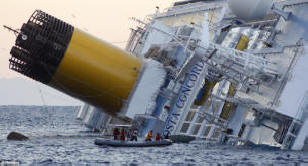|
Unique Cruise Solutions The news you need to know |
|||||||||||||||||
|
|||||||||||||||||
 |
|
|
|||||||||||||||
|
Cruise News for the Corporate Travel Professional |
|||||||||||||||||
|
Salvaging the Concordia |
||||||||||||||||
 While
the Costa Concordia investigation moves ahead, questions and rumors loom over
the amount of damage to the vessel, and what exactly the cruise line will do
with the ship. Right now, the vessel has been seized by the authorities, the
search continues for a number of missing people, and the ship also poses a
significant environmental threat with tons of heavy fuel oil onboard. While
the Costa Concordia investigation moves ahead, questions and rumors loom over
the amount of damage to the vessel, and what exactly the cruise line will do
with the ship. Right now, the vessel has been seized by the authorities, the
search continues for a number of missing people, and the ship also poses a
significant environmental threat with tons of heavy fuel oil onboard.However, if the authorities do release the vessel, and environmental concerns are dealt with, salvaging the 114,500-ton ship could be viable, according to industry experts. “I think that foremost the vessel must me stabilized to prevent further water intrusion. This would involve sealing the exposed hull,” said Ed Okun, director of Seahorse Diving, and himself a long-time salvage diver. Seahorse provides various underwater services to the cruise industry, including underwater maintenance, hull cleaning, propeller cleaning and more. “Teams of welders will need to be placed on the side of the ship after they have determined that it is not likely to slip any further out into deep water and weld plating over the exposed gash in the hull. The fact that it sits apparently on a slope could complicate things if the winter seas pound the vessel and create a surging effect,” he continued. He added that fuel barges will need to be brought in to pump fuel out of the ship, and that the salvage companies involved would have to try to seal interior compartments. “The vessel must be brought back to a sailing trim so that it can be towed to the nearest dockyard. It would be nearly impossible to tow capsized. It may be days before a meaningful assessment of the damage that is still below the waterline can be performed,” continued Okun. “Conversely, the surge effect under the vessel can create a very hazardous situation for the salvage divers as they approach the vessel near the seabed. A strong Venturi effect is caused by tidal flow between the hull and seabed which can pull a man helplessly under the vessel, potentially trapping him under a surging hull. These hazards need to be addressed before any productive work can be accomplished. “All this being said, it could be done, it's certainly not the most complicated salvage ever planned because of the new condition of the vessel’s structure, but the sheer size of this vessel compounds the difficulty factor greatly,” Okun explained. |
|||||||||||||||||
|
|
|||||||||||||||||
|
|
|||||||||||||||||
|
|
|||||||||||||||||
|
Worldwide Travel & Cruise Assoc., Inc. 150 S. University Dr. Ste E, Plantation, FL 33324 - USA Tel: +1 954 452 8800 Fax: +1 954 252 3945 EMail: sales@cruiseco.com |
|||||||||||||||||
|
Designed & Published by: Worldwide Media. |
|||||||||||||||||




